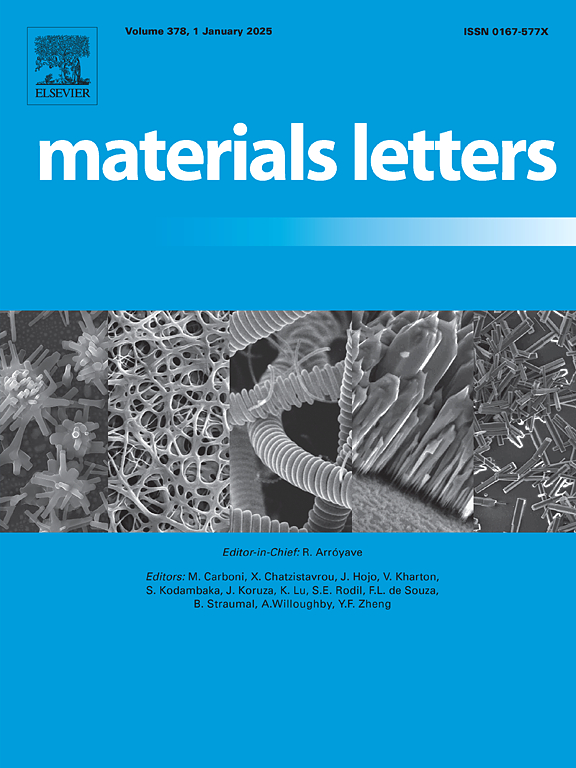Optimization of ZrB2 content in CoCrNiFeAl high-entropy alloy coatings: experimental and simulation study of microstructure and wear resistance
IF 2.7
4区 材料科学
Q3 MATERIALS SCIENCE, MULTIDISCIPLINARY
引用次数: 0
Abstract
CoCrNiFeAl high-entropy alloy (HEA) composite coatings with various ZrB2 contents (10 wt%, 20 wt%, and 30 wt%) were fabricated on 316 stainless steel substrates using additive manufacturing. The effects of ceramic phase content on the phase composition, grain size, hardness, and tribological behavior of the coatings were systematically investigated. XRD, EBSD, and SEM characterizations revealed that ZrB2 addition promoted the FCC-to-BCC phase transition and significantly refined the grain structure. Tribological tests showed that the 20 wt% ZrB2 coating had the most stable coefficient of friction and the highest wear resistance. However, excessive ZrB2 (30 wt%) content resulted in ceramic particle agglomeration, localized stress concentrations, and interfacial degradation. Finite element modeling using the Digimat/ANSYS platform confirmed the stress amplification effect in agglomerated regions. Overall, according to observed mechanical properties, 20 wt% ZrB2 content was identified as the optimal reinforcement level for this system.
CoCrNiFeAl高熵合金涂层中ZrB2含量的优化:显微组织与耐磨性的实验与模拟研究
采用增材制造技术在316不锈钢基体上制备了不同ZrB2含量(10 wt%、20 wt%和30 wt%)的CoCrNiFeAl高熵合金(HEA)复合涂层。系统地研究了陶瓷相含量对涂层相组成、晶粒尺寸、硬度和摩擦学性能的影响。XRD、EBSD和SEM表征表明,ZrB2的加入促进了fcc到bcc的相变,晶粒结构明显细化。摩擦学试验表明,20wt % ZrB2涂层具有最稳定的摩擦系数和最高的耐磨性。然而,过量的ZrB2 (30 wt%)含量会导致陶瓷颗粒团聚,局部应力集中和界面降解。利用Digimat/ANSYS平台进行有限元建模,证实了聚集区域的应力放大效应。总体而言,根据观察到的力学性能,20 wt%的ZrB2含量被确定为该体系的最佳增强水平。
本文章由计算机程序翻译,如有差异,请以英文原文为准。
求助全文
约1分钟内获得全文
求助全文
来源期刊

Materials Letters
工程技术-材料科学:综合
CiteScore
5.60
自引率
3.30%
发文量
1948
审稿时长
50 days
期刊介绍:
Materials Letters has an open access mirror journal Materials Letters: X, sharing the same aims and scope, editorial team, submission system and rigorous peer review.
Materials Letters is dedicated to publishing novel, cutting edge reports of broad interest to the materials community. The journal provides a forum for materials scientists and engineers, physicists, and chemists to rapidly communicate on the most important topics in the field of materials.
Contributions include, but are not limited to, a variety of topics such as:
• Materials - Metals and alloys, amorphous solids, ceramics, composites, polymers, semiconductors
• Applications - Structural, opto-electronic, magnetic, medical, MEMS, sensors, smart
• Characterization - Analytical, microscopy, scanning probes, nanoscopic, optical, electrical, magnetic, acoustic, spectroscopic, diffraction
• Novel Materials - Micro and nanostructures (nanowires, nanotubes, nanoparticles), nanocomposites, thin films, superlattices, quantum dots.
• Processing - Crystal growth, thin film processing, sol-gel processing, mechanical processing, assembly, nanocrystalline processing.
• Properties - Mechanical, magnetic, optical, electrical, ferroelectric, thermal, interfacial, transport, thermodynamic
• Synthesis - Quenching, solid state, solidification, solution synthesis, vapor deposition, high pressure, explosive
 求助内容:
求助内容: 应助结果提醒方式:
应助结果提醒方式:


